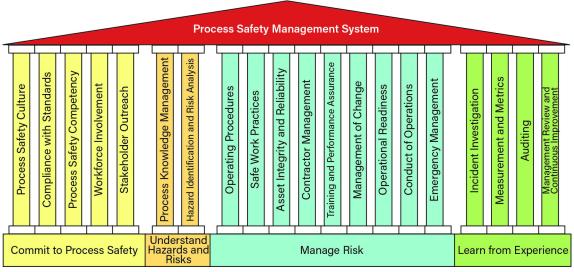In the book Inviting Disaster: Lessons from the Edge of Technology (1), author James Chiles introduced “robbing the pillar” as a useful safety metaphor:
During the mine tour, the guide talked about an old practice called “robbing the pillar.” In regions having horizontal layers of coal, miners would blast and muck out a room but leave massive pillars of coal at regular intervals to shore up the roof. When most of the coal was out of a room, a few men went back to shave the pillars to get as much coal as they could. To survive, a miner needed to stay in close touch with anyone else working in the room, and each man needed to know how much the other guy was weakening the pillars across the room at the same time. Working too independently, together they would bring down the roof. The safety of high-power technology stands on pillars too, and they can be weakened at any time during the lifetime of a system, from design through construction, from routine operations through disposal (1).
Robbing the pillars in coal mines provided additional financial gain, but taking away too much could lead to roof collapse and injury (Figure 1). Chiles illustrates this metaphor using the Bhopal incident as one example, where safety systems were shut down and maintenance was delayed.

▲Figure 1. Robbing the pillars of a coal mine can net additional profit. However, taking too much coal weakens the pillar, which can cause a roof collapse and death of the miners. Photo courtesy of CardCow.com Vintage Postcards and Collectibles.
AIChE’ s Center for Chemical Process Safety (CCPS) has defined 20 elements of a risk-based process safety (RBPS) management system that are grouped into four main accident prevention pillars (Figure 2) (2):
- commit to process safety
- understand hazards and risks
- manage risk
- learn from experience.

▲Figure 2. A risk-based process safety management system incorporates four main accident prevention pillars, which are composed of 20 elements.
The concept of robbing the pillars should lead us to question what we are doing, or perhaps not doing, that may be reducing the safety margins and effectiveness of our safety programs in these and other areas, degrading our safety performance, and ultimately, increasing the risk of serious incidents and injuries.
What may be robbing the pillars will of course vary from one company or site to another. A careful look at safety program effectiveness, though, can provide insights. Some possible factors include:
- poor measurement of safety program performance to identify warning signs of potential problems, including failure to properly review and/or follow-up on data in a timely manner
- a focus on regulatory compliance vs. evaluation and management of actual workplace hazards, some of which may not be covered by regulations
- lack of or inconsistent leadership commitment to safety as a core value, awareness and knowledge of safety programs and culture, and/or visible day-to-day focus on and support for safety priorities
- poor management of organizational change, including staff reductions, loss of expertise, and training strategies, that can lead to loss of organizational capability and knowledge
- incomplete or disorganized documentation of critical process design and safety information, contributing to difficulty in evaluating and managing technical changes
- ineffective design, implementation, and/or improvement of safety management systems, including risk management evaluations, training, and preventive maintenance
- organizational complacency, based on past good safety performance or other factors, which may or may not continue as circumstances change
- lack of a focus on human error and operational discipline in consistently following operating procedures and safety program requirements, and failure to develop capabilities for recognizing and responding to changing conditions.
In her book, Engineering a Safer World: Systems Thinking Applied to Safety (3), author Nancy Leveson points out that deterioration of safety systems and performance is likely:
Rather than accidents being a chance occurrence of multiple independent events, they tend to involve a migration to a state of increasing risk… Systems and organizations continually experience change as adaptations are made in response to local pressures and short-term productivity and cost goals… A corollary to this propensity for systems and people to adapt over time is that safety defenses are likely to degenerate systematically through time (3).
The concept of robbing the pillars serves as a reminder that systems often degrade over time without appropriate and consistent attention to evaluating and continuously improving safety program performance (4). Safety margins, perhaps already thin to begin with, can get smaller, leading to higher risk of serious incidents and injuries. Consider asking what may be robbing the pillars of your safety programs. What are you doing or not doing that is reducing your safety program effectiveness and what can you do about it? Good safety program performance depends in part on making sure we do not rob the pillars of our programs to the point where the roof caves in.
Jim Klein, CCPSC, CPSA, is President of Process Safety Performance LLC (Email: jim.pspllc@gmail.com). He is a Fellow of both AIChE and CCPS.
- Chiles, J. R., “Inviting Disaster: Lessons from the Edge of Technology,” Harper Collins, New York, NY (2001).
- Center for Chemical Process Safety, “Guidelines for Risk Based Process Safety,” AIChE and Wiley, Hoboken, NJ (2007).
- Leveson, N. G., “Engineering a Safer World: Systems Thinking Applied to Safety,” MIT Press, Cambridge, MA (2011).
- Klein, J. A., “Factors That Impact Safety Performance and How They Can Be Used to Achieve and Sustain Excellent Performance,” Professional Safety, pp. 48–52 (June 2021).

Copyright Permissions
Would you like to reuse content from CEP Magazine? It’s easy to request permission to reuse content. Simply click here to connect instantly to licensing services, where you can choose from a list of options regarding how you would like to reuse the desired content and complete the transaction.
